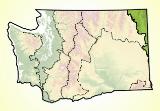 © Pete Saloutos/Panoramic Images (Washington Title Image Large)
© Pete Saloutos/Panoramic Images (Washington Title Image Large)

Canadian Rocky Mountains Human Impact
The Canadian Rocky Mountain ecoregion remains intact ecologically but still faces threats to biodiversity conservation, including:
- Past forest management practices. Most of the ecoregion’s forests have seen changed composition and function because of customary harvesting practices, such large clear cuts, single species selection, and removal of dead and downed trees. Habitat fragmentation affects vulnerable animals such as mountain caribou, fishers, and goshawks.
- Changes in fire frequency and intensity. The alteration of the natural fire regime has changed water, nitrogen, and carbon cycles. The denser forest of smaller trees that has resulted is more prone to disease, insects, and large fires.
- Recreation and sprawling development. The Canadian Rocky Mountain ecoregion has become an outdoor playground. Plant and wildlife habitats suffer when lands are converted to golf courses and vacation homes.
The Selkirk Mountains, with their extant populations of mountain caribou, grizzly bears, gray wolves, lynx, and martin, offer an excellent opportunity to conserve the integrity of this ecoregion. Partnerships among agencies, residents, and recreationists will be vital to finding solutions to these conservation challenges.
For details of this ecoregion within Washington, click a subheading in the left column.



